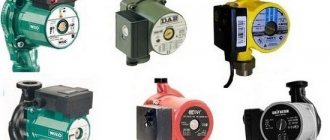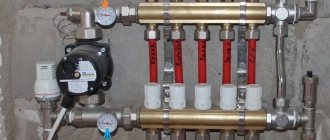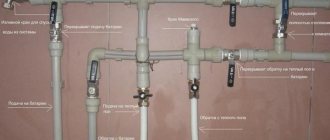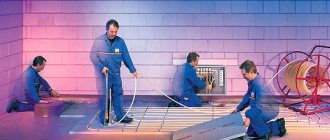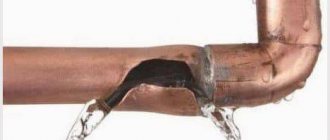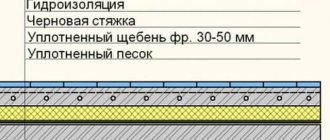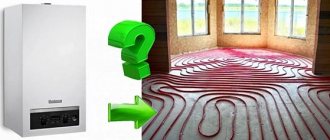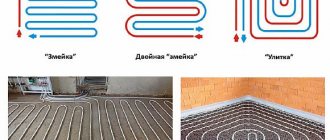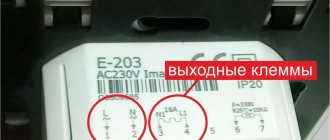The accumulation of air in the heating system prevents it from functioning properly. If you do not remove it in time, performance will deteriorate. Under such conditions, the likelihood of breakdowns of expensive equipment increases. To eliminate unnecessary risks and extra costs, you need to know how to pump a heated floor yourself. The technique is quite simple, so in most cases, contacting specialized specialists is not required.
Inspection and troubleshooting should be carried out before the start of the regular heating season.
How problems appear
In parts of the system that are connected to radiators, problems can be detected quickly. They are located indoors, so noise is heard when air passes through. By touch, the low temperature of individual sections of the batteries where gas “plugs” have formed is determined.
But the pipeline, hidden deep in the concrete screed, is well insulated. If the cabinet with a collector comb and pump is installed away from living rooms, extraneous sounds will not be heard. Malfunctions are detected by significant differences in heating in different circuits.
The following list shows the reasons that contribute to the penetration of air into the coolant:
- Replacement of taps and other system elements;
- Faulty condition of automatic devices that are designed to remove air from the system;
- Laying a pipeline route with large differences in height;
- Significant change in pressure level during operation. With low pressure, voids may form at the top points;
- Excessive heating of the coolant, accompanied by the release of gases. Some types of chemical compounds can cause similar negative processes;
- The process of filling the system after the summer period was carried out too quickly, so not all the air was removed;
- During installation of the system or later, the tightness of the connections was broken. In the worst case scenario, leaks have formed inside the concrete screed. For this reason, after installing heated floors, a thorough check is carried out using high pressure.
Formation of air masses in a heated floor system
A pump will be useful to bleed the system.
How to bleed air accumulated in the system will depend on the case that led to such a result.
Some circumstances require immediate intervention, while others are not capable of causing significant damage to the system.
If the heated floor was installed with noticeable differences, it is worth acquiring an additional pump for pumping the coolant.
It is recommended to install several automatic air vents that will help bleed air masses from the system. One is installed on the return lines, while the second should be on the supply.
Running the circulation pump will also help expel excess air. The more air that has accumulated, the louder the circulation pump will operate. It is worth paying attention that the system must be pumped at maximum speeds. This will significantly save time and allow you to completely remove air from the system. If it was recently pumped, but the air has already collected again, the problem may be in the pump itself.
Air vent
With the comb installed, each circuit is closed in turn, and the air vent must be open on each of them. It is necessary to bleed air gradually, so after cleaning the first circuit, the next one opens. The descent is carried out in stages and at the moment of bleeding only one circuit should be open.
If this procedure does not give the expected result, the next air release should be carried out no earlier than in a few days.
To properly clean the system, a person must understand the structure of the comb and understand the principle of its operation. If you do not have the necessary knowledge, you should seek help from specialists. For more information on releasing air, watch this video:
Recently, separators have become increasingly popular, whose function is to automatically remove air bubbles from the system, which significantly simplifies the further operation of the entire system.
Why do you need to remove air?
The formation of voids reduces the efficiency of the heating system. Pumping equipment, like other components, operates less efficiently. To ensure comfortable indoor temperature conditions for users, more resources have to be spent.
As such voids increase, the pressure gradually decreases. After reaching the maximum minimum level, the corresponding signal is sent to the boiler control unit. In addition to electronic devices, mechanical means for similar purposes are used. This is an emergency situation, so the automation turns off the supply of gas or other fuel.
To turn it on again, you have to manually increase the pressure. But there are a lot of gaseous inclusions in fresh water, so negative processes are accelerated. The equipment will turn off more often.
It is dangerous to leave it in this condition without constant supervision. If the air is not removed while simultaneously eliminating the underlying causes, the equipment will completely lose functionality.
It should be remembered that oxidation, which destroys metals, occurs in the presence of water and oxygen. Adding a new coolant activates the corresponding negative processes. In this operating mode, the durability of heating equipment is reduced.
It is necessary to exclude the appearance of air “plugs” in the heat exchange units of boilers. These parts are exposed to very high temperatures.
If heating is not uniform enough, the heat exchanger will be damaged beyond repair.
The reasons listed above are enough to understand the need for preventive measures. Carrying them out will prevent complex breakdowns and costs associated with restoration work.
Prerequisites for the appearance of air
For preventive purposes, it is recommended to remove air before starting the entire heating system. It accumulates, as a rule, at the highest points of the heat pipeline, which are the collectors.
To guarantee success, it is better to be patient; sometimes the process lasts a couple of days, especially if gas has entered the circuits and, therefore, it is advisable to vent the air 7 to 4 days before starting the system. It is also recommended to bleed air plugs during the last few days at the end of the heating season.
To understand the methods for solving the problem, you need to consider the common causes of it getting into the heating.
Penetration is usually caused by a number of factors:
- a sharp drop in pressure in one of the heating circuits or overheating of the working fluid;
- technological factors, leakage, violation of system collection technology (angle of pipe laying, errors in the installation of the manifold, lack of taps on the distribution manifold to relieve excess pressure;
- starting the system without initial air removal.
Before “de-airing” the system during a test run, the working fluid is not heated, this can aggravate the situation.
Design features
It is necessary to take into account in advance the details that distinguish certain equipment. So, in some situations, a built-in boiler pump is used to circulate coolant throughout all circuits. For a large facility, its performance may not be enough, so you will need to install a separate power unit.
When using radiator heating, routes are created with a minimum number of turns, without sharp corners. By adding tilts towards the boiler, natural circulation can be ensured under the influence of gravity.
In heated floors, long pipelines with a large number of bends are installed
It is more difficult to pump water through such a system. Only coercive methods are used here. If there are errors in the calculations, the power of a separate pump will not be enough for distant circuits. In this case, their poor heating cannot be eliminated by removing air plugs. The system will need to be modernized.
The comb regulators must first be correctly adjusted. In addition to mechanical flow meters, valves with electric drives are installed. Such devices change the coolant supply rate taking into account the readings of temperature sensors.
Automated adjustment system
Air removal algorithm
As the coolant moves through the system, gas accumulates at the highest points. For a heated floor system, this is a manifold distributor (comb). Mayevsky taps or automatic air exhaust devices are screwed into them during installation.
Might be interesting
Thermal insulation
How to insulate a roof from the inside and not make mistakes?
Thermal insulation
Roofing and drainage: heating rules
Thermal insulation
Insulated Swedish stove: pros and cons
Thermal insulation
Penoizol: self-production
Below is the standard sequence of correct actions:
- Many modern pumps of this type are equipped with a step speed controller. It is set to position “1”, which corresponds to minimum performance. It will take more time, but the removal of gases will be accurate.
- Overlap all contours except one. Further, similar operations are performed sequentially in other areas.
- The screw of the Mayevsky primary circuit valve is turned with a slotted screwdriver in a counterclockwise direction. Before this, the polymer insert is turned with the hole down, and a suitable container is placed to collect the liquid.
- After the air has escaped, the screw is turned in the opposite direction until the tap is completely closed.
- Despite the fact that the minimum engine speed is set, the circuit will have to be pumped repeatedly. After the first release of gases, the pump is turned off. Wait for air to accumulate in the tap, open the tap. Next, power is supplied to the electric drive again, and the coolant is circulated at low speed for several minutes.
- This procedure is repeated 3-4 times. Afterwards, turn off this circuit with a tap and move on to the next one.
Typical pump with red shaft speed control knob
If the pump is installed above the comb, or only a standard unit (heating boiler) is used, air can also be released from it. To do this, slightly loosen the screw located in the center of the cover. In the picture above it is marked with an arrow.
After completing the entire set of work actions, the pressure will need to be raised to the nominal level. It should be understood that during this procedure air will again enter the system. Therefore, it is possible that we will have to release it again.
How to expel air from a warm water floor?
It is a well-known fact that air in heating systems accumulates at the highest points of the system. For underfloor heating systems, this is a collector comb, where air discharge devices are installed (Mayevsky valves, automatic air vents or conventional ball valves).
Mayevsky tap installed on the underfloor heating manifold.
To remove air from the underfloor heating system, you must perform the following steps in a certain sequence:
- Shut off all horizontal branches on the collector.
- Remove air from the circulation pump housing.
- Open the Mayevsky valve or ball valve on the comb (in the absence of automatic devices).
- Open the first water circuit, start the pump, setting the minimum capacity on the regulator.
- After waiting for water to appear from the air outlet of the pumped branch, turn off the tap and turn off the pump.
- Repeat the operation several times at intervals of 5 - 6 minutes until the air is completely removed.
- Similarly, perform all operations with the remaining contours.
- Then, switching the pump to maximum performance, pump the entire system as a whole, periodically bleeding air.
- Considering the likelihood of new plugs forming during subsequent warming up of the system, it is necessary to bleed the air again.
When using automatic gas vents or separators as air removal equipment, no additional means are required. It must be remembered that as the complexity and quantity of equipment used increases, the cost increases and the reliability of the system as a whole decreases.
The lower the degree of automation of the process, the higher the performance of heated floors. Adjustable manifold valves with a mechanical drive, Mayevsky taps are easy to service or replace with your own hands.
Repair of more complex equipment with servo drives and automation units requires the participation of specialists. In addition, automatic air vents, while effectively removing air pockets, do not always allow immediate detection of system leaks.
At the first stage, the valves of all circuits on the manifold, except one, are closed. Next, the circulation pump is turned on at the lowest speed (high speed will lead to the suction and breaking of air masses into small bubbles, followed by pushing them along with the mass of water through the pipes). In this case, the pressure created should exceed normal by 15-20%. When all the air mass has left the circuit, it is blocked and they move on to another.
Air is removed from each heating circuit connected to the manifold separately, with the remaining circuits closed.
The operations are repeated for 2-3 days, after which you can begin heating the coolant and the start of the heating season.
How to bleed air from a warm water floor? Separator devices will help. Their main purpose is to automatically remove air from the system without the need for outside assistance.
Collectors and circulation pumps are equipped with drain valves and taps, the internal space of which can also be aired. To prevent this from happening, the pump must be installed exclusively for supply.
During the descent period, power surges in the network must be excluded. For this purpose, the pump driving water should be connected to an uninterruptible power supply. Experts know how to bleed air from a warm water floor that has already entered the pipes. This is quite a troublesome task, and achieving the goal takes several days.
Components of equipment
It is worth taking a closer look at the parts of the system that were mentioned above.
Disassembled crane
The operating principle is described in the air release instructions. The design of the Mayevsky crane is easier to study using this drawing. Such a miniature product is installed instead of a plug in the upper part of the collector comb. There is a carving in the central part. A screw is screwed in there, pressing the plastic seal.
To ensure the tightness of the connection, a rubber ring is used. All listed parts are included as standard with the product. No additional consumables are required for installation and operation.
The use of automated devices greatly simplifies the task. Without careful user control and additional settings, they are able to perform their functions over a long service life.
Automatic gas vent
Here is a schematic diagram of one of the devices in this category:
- The node (1) creates a rigid fastening of the rod (2) to the inside of the body with the desired angle. They regulate the opening level of the exhaust valve.
- During operation, air accumulates in the upper part. The float goes down. In a certain position, it will open the shut-off device, which will release the gas out.
- Next, the float rises to its original position, and the cycle repeats again.
- A soft seal (4) is installed in the lower part, ensuring the tightness of the connection.
Separator
The following device performs similar functions more effectively:
- Here is an example of a flow separator. It is installed at the top point in the pipeline section using threaded connections (4, 5).
- A mesh (3) is fixed in the central part. When a stream of water passes through such a structure, air bubbles are released from it (2).
- They rush upward. The same unit is installed in this part as in the automatic gas vent. When the float drops below a certain level, the draft will open the valve (1) to release air to the outside.
- The cell sizes and other mesh parameters are selected so as not to create unnecessary obstacles to the movement of the coolant. However, this design traps rust particles (6). They accumulate at the bottom (7). There is a screw-on cap that can be opened to remove contaminants when performing routine maintenance.
Removing mechanical impurities reduces the load on different parts of the heating system. If you install a simple filter on the main water supply line, clogging of radiator ducts and boiler heat exchangers will be prevented. This will also extend the life of the valve jets of automatic air vents.
Additional recommendations
As complexity increases, the cost increases, but the overall reliability of the equipment decreases. As an example, control valves on a manifold comb can be used. Designs with mechanical drives cost little.
Their characteristics have been developed over many years of practice, so breakdowns rarely occur. Servo drives are more expensive. The corresponding systems contain electronic units, miniature electric motors, wire connections, and sensors. There are more components that can fail.
The components for removing air from the system should be selected taking into account the design features. Simple Mayevsky cranes are capable of performing their functions flawlessly for a long time. They do not need to be adjusted during operation. Automatic devices are more complex and more expensive. They can be damaged by dirt, so they need protection from mechanical impurities.
Sometimes intensive formation of air pockets indicates violations of the integrity of connections or other damage. Automatic diverters are so effective that it will not be possible to notice the appearance of problems in the early stages.

